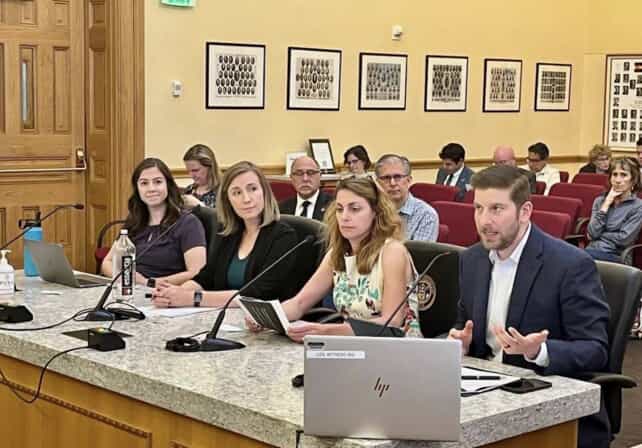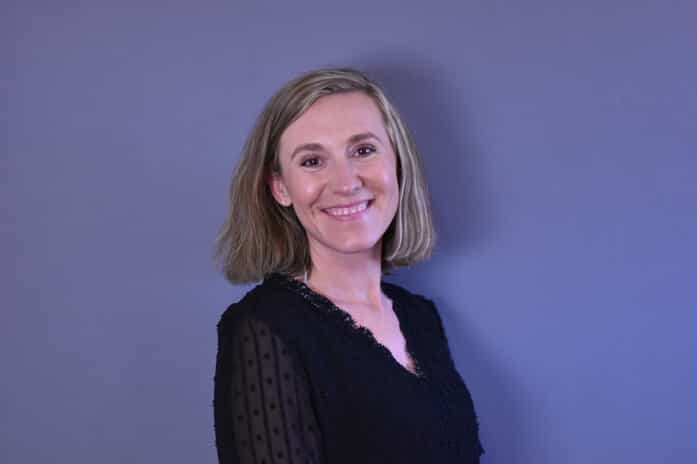Reich Loy Represents SLVH on Panel
SLV Health
CHA Presents to the Opioid and Other Substance Use Disorders Study Committee
In August of 2023, the Colorado Hospital Association (CHA) put together a panel to present the vital role hospitals play in substance use disorder (SUD) care to the state’s Opioid and Other Substance Use Disorders Study Committee.
The panel highlighted the vital role hospitals play in addressing SUD and the challenges related to stigma, clinical training, and policy.
They also discussed how outcomes can be improved by empowering multidisciplinary clinical teams, including those with lived experience, and focusing on prevention, treatment, harm reduction, and recovery within hospital settings.
CHA will continue to engage with the Committee on opportunities to enhance SUD care as they make recommendations to the General Assembly for the 2024 legislative session.

Left to right: Angela Swafford, AM, LCSW, UC Health System; Audrey Reich Loy, LCSW, LAC, SLV Health; Susan Calcaterra, MD, MPH, MS, University of Colorado Hospital; and Richard Bottner, DHA, PA-C, CPHQ, FACHE, CHA Vice-President of Clinical Excellence.
Audrey L. Reich Loy, San Luis Valley Health's Director of Program Operations, gave the following testimonial:
Good morning, Chair deGruy Kennedy and members of the Committee. My name is Audrey Reich Loy, and I am the Director of Programs at San Luis Valley Health, located in the southwestern region of our state. I began my career as a social worker in the clinical setting and now take that experience to oversee program operations for San Luis Valley Health, including our significant work on substance use disorders.
San Luis Valley Health is a non-profit comprehensive healthcare organization serving approximately 46,000 people across a region that is bigger than the state of Connecticut. We are surrounded by mountains in all directions, and our closest, larger healthcare partners are at least 120 miles away. All six counties are designated as Health Professional Shortage Areas and are ranked as having some of the highest opioid-related overdoses in Colorado. We made national news about ten years ago for the exorbitant number of prescriptions for opiates being filled locally, making us the epicenter of this crisis.
Despite these incredible barriers, our frontier nature inspires our ability to roll up our sleeves and problem-solve with limited resources. Isolated healthcare providers have no choice but to build substance use response services within its service delivery because we are often the only option for patients and families. For us, this has included screening patients for mental health and substance use, providing care coordination to address linkages to specialty services and social determinants, and staffing teams with behavioral health providers, where available, to respond to higher acuity needs. We have trained providers in Medication Assisted Treatment. And we have maximized our partnerships with local community providers to fill gaps and develop expertise beyond our walls. Our providers spearheaded the grassroots effort in the Valley ten years ago, to develop community-wide processes to respond to the prescribing epidemic, to better manage pain, and to modify prescribing practices.
However, it’s impossible to go far enough with limited resources, and we continue to face extreme barriers, both universal to healthcare providers in Colorado, as well as unique to those serving rural communities. Barriers we continue to face include:
- Financial hardships – San Luis Valley Health operates at a less than 1% margin. Therefore, we must either prioritize and do without, or get creative in our financial portfolio. Grants have funded much of the work we’ve done in this space, but as you know, grants require sustainability. While we participate in many of the latest alternative payment models, the newness and unpredictability of this phase in healthcare doesn’t offer the level of sustainability needed to address the massive problems we face in managing this population. Outside of those options, we are limited to our operating margin. As long as insurance billing remains complex and limited to one condition priority at a time, we cannot bill for the services we provide in a medical setting.
- Staffing shortages – Like the nation, San Luis Valley Health faces tremendous obstacles in recruiting and retaining healthcare staff. However, rural healthcare providers have faced recruitment challenges long before the COVID pandemic. Recruiting for more specialized roles, such as behavioral health and substance use providers, has only become harder. In fact, it can take over a year to fill one of our few Behavioral Health roles.
- Scope of the problem – Our teams do incredible work to support wraparound services, but it is easy to get disillusioned when confronted daily with the scope of the problem. As mentioned previously, our community worked tirelessly to clean up the prescribing practices of the past and made a significant improvement toward addressing the opioid epidemic. However, we continue to see an increase in the use of illicit drugs and crime, thus posing new challenges to providers in our region. Along with our community partners, we have made measurable efforts toward building capacity in partnership with other organizations, but we as a community continue to fall short of having the necessary safety net available to respond to the medical and substance use complexities we are facing.

If I can leave you with nothing else today, as you consider solutions, I ask that you keep in mind:
- Not all hospital systems are created equal. As such, the goal should be to achieve equitable resourcing, not equal resourcing. As an organization working within a less than 1% margin attempting to serve a complex and high-acuity population, our challenges are different than some of our partners across the state, and thus, solutions must look different.
- Hospitals must be considered within the continuum of care needed to address substance use disorders, and this must include more than Emergency Departments. Emergency Departments are not designed to fully respond to this epidemic in a holistic manner, and we leave out the many opportunities we have to reach this population through our inpatient and community-based encounters. We must “strike while the iron is hot” by creating “no wrong door” for a patient struggling. This can only happen with a breadth and depth of 24/7 access needed to meaningfully respond to this population.
- That our workforce shortage is not a one-dimensional problem. Recruiting the workforce to rural communities has only become harder since the COVID-19 pandemic. Without robust wraparound resources available and accessible for patients struggling, burnout and migration can only continue, thus leaving our rural communities vulnerable to ongoing adversity.
I fear we are racing to the edge of a cliff as we assess the growing acuity of those struggling with substance use disorders, paired with the continued complexities facing healthcare organizations statewide. Costs are not going down. Reimbursement models are not changing at the rate needed to respond accordingly. The demand on healthcare providers only continues to rise. And rural communities will never stop relying on their local hospitals as their trusted partners in healthcare.